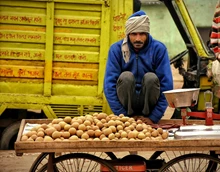Multilayer farming enables more crops to be produced in less area. Akash Chaurasia, the movement's pioneer, is at the helm. With over 20 national accolades to his name, the 32-year-old has trained over 80,000 farmers and taught approximately 12 lakh people about multilayer farming.
He grew up in Sagar, a tiny town in Bundelkhand, Madhya Pradesh, to a family of betel nut growers, to become a doctor. He realized that what we eat and drink is the basis of all ailments." And he decided to address the source of the problem through farming.
The Discovery of Multi-Layer Farming
After committing to farming, Akash visited with various farmers and began to consider all of the concerns they face today, from water and fertilizer issues to climate change and insect attacks to marketing and sales.
So, in 2014, as a solution to all of these issues, he devised the concept of growing different crops on the same plot of land. He began by planting two layers of crops, one underneath and one on the surface. Tomatoes and bitter gourd were his initial crops, and he tried other combinations as well.
Akash quickly encountered his first set of obstacles, grass, and weed. The seeds produce a lot of grass, weakening the crop and eliminating them is expensive.
To offset this, he added green crops similar to those grown on the surface, such as spinach, coriander, fenugreek, and others. By planting fast-growing leafy crops, there is less area for grass. The grass is around 80% managed inside this model.
Advantages of Multilayer Farming
The several layers of crops keep water from evaporating. When compared to an open field, around 80% of the water is conserved. Although an open field consumes 100 liters of water for one crop, a multilayer farm uses just 30% of that amount for four crops. Each crop grows with around 7% water."
In addition, compared to an open field fair, around 93 liters of water is conserved.
Growing Crops Throughout the Year
With the four varieties of crops, the farmer is also earning a parallel income from each. For instance, from March to July the leafy green vegetables, in this case, spinach, offer income to the farmer.
From April to November, the creepers, like scarlet gourds, fruits. In August, the underground crop like ginger matures and makes itself available for selling. And from December to January, the papaya tree gives its fruits. There isn’t a single week in which his income does not generate. His model makes farmers more economically independent. Akash himself has an annual income of Rs 30 lakh.











